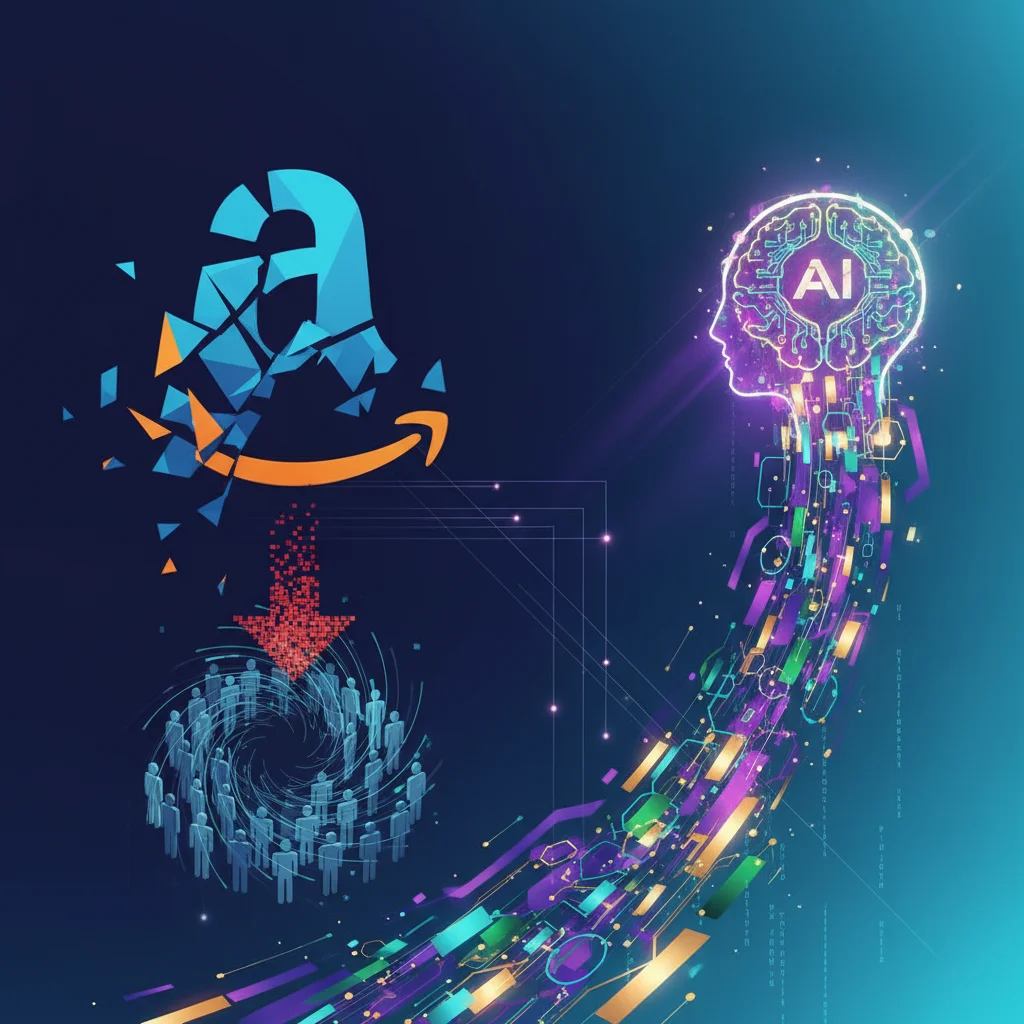
Amazon’s Shocking Pivot: Why 14,000 Layoffs Are Fueling an AI Revolution
It’s a headline that stops you in your tracks: Amazon, the seemingly unstoppable behemoth of e-commerce and cloud computing, is cutting 14,000 corporate jobs. On the surface, it looks like another grim data point in a wave of tech industry contractions. But if you look closer, this isn’t just about reining in costs. It’s a calculated, strategic, and seismic shift. Amazon is shedding its skin, trimming the fat from a decade of hyper-growth to pour every available resource into its next great conquest: the era of artificial intelligence.
This move is a powerful signal for everyone in the tech ecosystem—from software developers and startup founders to seasoned executives. It tells us that the “growth at all costs” mantra that defined the last decade is officially over. The new playbook is about lean operations, ruthless efficiency, and a laser-focus on the technologies that will define the future. For Amazon, that future is unequivocally AI.
In this deep dive, we’ll unpack the real story behind the headlines. We’ll explore why these cuts are happening now, where the investment is being redirected, and most importantly, what it means for your career, your business, and the industry at large.
The End of an Era: Deconstructing the “Great Tech Correction”
To understand Amazon’s decision, we have to zoom out. The tech industry is currently navigating a hangover from the pandemic-fueled hiring frenzy. During 2020 and 2021, as the world moved online, tech giants went on an unprecedented hiring spree to meet skyrocketing demand for digital services, e-commerce, and cloud infrastructure. However, as the global economy shifted and interest rates rose, investor sentiment changed. The new demand from Wall Street wasn’t for moonshot projects and sprawling headcounts; it was for profitability and sustainable growth.
Amazon was not alone in this course correction. The entire sector has been recalibrating, leading to widespread layoffs that have reset the tech talent landscape. This isn’t a sign of a dying industry, but rather a mature one adapting to new economic realities.
To put this into perspective, let’s look at how Amazon’s cuts compare to its peers in what many are calling the “Great Tech Correction.”
| Company | Approximate Number of Employees Laid Off | Stated Reason |
|---|---|---|
| Google (Alphabet) | ~12,000+ | Re-engineering cost base, focusing on AI priorities |
| Meta (Facebook) | ~21,000+ (in multiple rounds) | “Year of Efficiency,” pivot to Metaverse and AI |
| Microsoft | ~10,000+ | Aligning cost structure with revenue, focusing on strategic growth areas like AI |
| Amazon | ~27,000+ (including previous rounds) | Cost-cutting, streamlining operations, and increasing investment in AI (source) |
As the table shows, this is a sector-wide phenomenon. The key takeaway is the consistent theme: companies are trimming headcounts in slower-growth or less strategic divisions to free up capital and talent for the next great technological arms race—the race for AI supremacy.
The Code Red Shift: Why Silicon Valley's Titans Are Ditching Liberalism for the New Right
The Phoenix from the Ashes: Doubling Down on the AI Gold Rush
So, where is all that capital and focus going? Straight into artificial intelligence and machine learning. Amazon isn’t just cutting costs; it’s reallocating its immense resources to ensure it dominates the next generation of computing. This isn’t just about a single product; it’s a full-stack assault on the AI landscape, from the foundational cloud infrastructure to consumer-facing applications.
Here’s where Amazon is placing its bets:
- AWS and Generative AI: The crown jewel, Amazon Web Services (AWS), is the primary battleground. While Microsoft made headlines with its OpenAI partnership, Amazon is fighting back fiercely with services like Amazon Bedrock. Bedrock is a managed service that gives developers access to a range of powerful foundation models (from AI21 Labs, Anthropic, Cohere, and Amazon’s own Titan models). This strategy turns AWS into a neutral “Switzerland of AI,” allowing startups and enterprises to build powerful AI-driven SaaS products without being locked into a single model.
- Developer Tools and Automation: Amazon is building tools to put AI directly into the hands of developers. Amazon CodeWhisperer, an AI coding companion, competes directly with GitHub Copilot. This focus on programming and software development is critical. By embedding AI into the developer workflow, Amazon increases its stickiness within the tech community and accelerates innovation on its platform.
- Reimagining Core Businesses: The AI investment isn’t just for AWS. Amazon is using machine learning to revolutionize its core e-commerce and logistics operations. Think of AI-powered supply chain automation, personalized shopping experiences that are more intuitive than ever, and a complete overhaul of its Alexa voice assistant to be a truly conversational, generative AI-powered companion.
What This Means for You: Navigating the New Tech Landscape
This industry-wide shift has profound implications for everyone. Whether you’re writing code, building a company, or managing a team, the ground is moving beneath your feet. Here’s how to stay ahead.
For Developers and Tech Professionals
The message is clear: AI skills are no longer a “nice-to-have”; they are the new currency. The demand is shifting from generalist software engineers to those who can build, integrate, and deploy AI and machine learning models.
- Upskill or Be Left Behind: Focus on learning Python, TensorFlow, and PyTorch. Get hands-on experience with cloud-based AI platforms like AWS Bedrock, Google’s Vertex AI, or Azure AI Studio.
- Think in a Full-Stack AI Context: It’s not just about training models. It’s about data engineering, MLOps (Machine Learning Operations), and understanding how to integrate AI into scalable, secure applications. This brings cybersecurity to the forefront, as securing AI systems is a massive and growing challenge.
- Embrace AI-Powered Tools: Learn to use tools like CodeWhisperer and Copilot. They are becoming the new standard for efficient programming. The developers who can leverage AI to augment their own productivity will be the most valuable.
The Billion COBOL Catastrophe: How Ancient Tech Fueled a National Crisis
For Entrepreneurs and Startups
While the headlines might seem intimidating, this shift creates incredible opportunities. Big Tech’s “fat-trimming” is a startup’s gain.
- A Richer Talent Pool: Thousands of highly skilled, experienced engineers, product managers, and marketers are now on the market. This is a golden opportunity for agile startups to acquire A-level talent that was previously locked up in FAANG companies.
- Build on the Shoulders of Giants: The new AI platforms from AWS, Google, and Microsoft are democratizing access to incredibly powerful technology. A small, focused startup can now build a sophisticated AI-powered SaaS product in months that would have taken a massive research team years to develop just a few years ago. The barrier to entry for AI innovation has never been lower.
- Find Your Niche: Don’t try to compete with Amazon on building foundation models. Instead, focus on applying these models to specific industry problems. The opportunities are in vertical AI—AI for law, AI for healthcare, AI for finance. Find a unique problem and use these new tools to solve it better than anyone else.
The Bigger Picture: A Tectonic Shift in Silicon Valley
Amazon’s strategic pivot is a microcosm of a much larger transformation. We are moving from the era of mobile and social to the era of AI and automation. This transition will be as disruptive and transformative as the rise of the internet itself. It will redefine jobs, create new industries, and challenge our assumptions about the role of technology in society.
The intense competition between Amazon, Microsoft, and Google is an “AI arms race” that will accelerate the pace of innovation exponentially. The advancements we see in the next two years will likely dwarf those of the last ten. For businesses, this means that integrating an AI strategy is no longer optional; it’s a matter of survival. Companies that fail to leverage AI to improve their products, services, and operations will be rendered obsolete.
This painful period of layoffs, while difficult for many, is ultimately forging a leaner, more focused, and more powerful tech industry. It’s an industry that is shedding the excesses of its adolescent growth spurt and maturing into a force laser-focused on solving complex problems through intelligent systems.
The Day the Cloud Stood Still: Is Our Big Tech Habit a Ticking Time Bomb?
Conclusion: The Dawn of a New Age
The layoff of 14,000 Amazon employees is more than just a cost-saving measure. It is a declaration of intent. It marks a definitive end to one chapter of the tech story and the explosive beginning of another. This is the moment where the industry’s full financial and intellectual might is being redirected towards the singular goal of building the AI-powered future.
For individuals and businesses, this can be a daunting time, but it’s also a moment of immense opportunity. The platforms are being built, the tools are being created, and the demand for those who can wield them is skyrocketing. The question is no longer *if* AI will change everything, but *how* you will adapt to be a part of it. The companies and professionals who embrace this shift, who learn the new skills, and who build on these new platforms will be the ones who define the next decade of technology.


